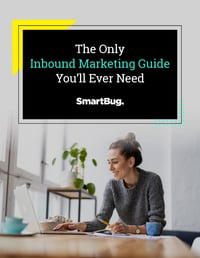
By Megan Golden
Imagine a world where, instead of reaching out to find leads and disrupting their day-to-day lives, your leads come to you. They seek you out to find solutions to their problems, and they raise their hand to let you know when they’re ready to talk.
If you’re not familiar with inbound marketing, it probably sounds too good to be true. But I have good news to share: That’s exactly what the world of inbound marketing is all about.
Inbound Marketing vs. Outbound Marketing
With outbound marketing, the company is starting the conversation—think cold calls, trade shows, TV ads, billboards, paid advertisements, and so on. If the company message is disrupting the potential customer’s normal activities, it’s likely an outbound marketing tactic.
With inbound marketing, you’re bringing interested leads to you when they start searching for the answers to their problems—think blog articles, e-books, opt-in emails, paid search ads, and social media. If the user is finding you with their own search, it’s likely an inbound marketing tactic.
The Benefits of Inbound Marketing
Why should you consider adding inbound marketing to your overall marketing strategy?
You’re likely already doing some inbound marketing tactics.
For example, if you have a blog you update regularly or pages on your website that address your ideal customer pain points, you’re already speaking to potential customers and hoping they find the content you’re sharing useful.
It’s very cost-effective.
With outbound marketing, you have to pay for the trade shows, TV commercials, billboards, and so forth, and you’re hoping the message reaches someone in a mass audience. But with inbound marketing, you’re creating content your target audience is already looking for.
You can better qualify your leads.
With outbound marketing, you’re hoping that someone sees your message and is interested in what you have to say, and maybe one day they’ll be ready to make a decision to reach out. In contrast, inbound marketing aims to be there when someone is ready to find a solution and nurture them through the buyer’s journey into being a customer. Based on their actions when interacting with your content, you can better qualify them as a lead.
Inbound Marketing Tactics
Now that you can answer, “What is inbound marketing?” and you can explain why you need to add it to your overall marketing plan, what tactics should you focus on first? Here’s a list to get you started:
Optimize the content on your website for search engines.
Focus on an SEO strategy that will increase the likelihood of your website showing up in search results for potential leads who are looking for solutions like yours.
Don’t forget a blog.
A blog naturally enhances your SEO efforts and regularly adds more content to your website related to your potential customers' pain points. Additionally, a blog allows you to act as a credible source in your industry.
Focus your content around the buyer’s journey.
Whether it’s a blog post or e-book, the content on your website should help leads move from one stage of the buyer’s journey to the next. A strong content strategy is vital to the success of your inbound marketing strategy.
Nurture your leads that aren’t quite ready to talk.
Ideally, everyone that hits your website would be ready to talk to sales, but let’s face it: In today’s world, there’s a lot of research that takes place before someone is ready to make a purchase. If you notice a contact has downloaded an e-book on your website, perhaps it might be time to share a case study with them via a lead nurture. This brings me to my next point ...
Utilize a marketing automation tool like HubSpot.
A marketing automation tool like HubSpot can help you track your inbound marketing efforts and make it easy to ensure that once visitors turn into leads, you nurture them through email marketing, chat flows, and automated workflows.
Keep in mind that inbound marketing is a complement to your entire marketing strategy. Whether it’s a PR campaign, TV commercial ads, or events and tradeshows, inbound marketing can help convert leads that come to your website from those efforts and eventually nurture them into customers.
This is just the tip of the iceberg. Learn more about inbound marketing in our Only Inbound Marketing Guide You’ll Ever Need.

About the author
Megan Golden was formerly a Senior Marketing Strategist for SmartBug. She has had previous experience with strategic campaign planning, content development, and implementing inbound marketing campaigns. She really enjoys collaborating with coworkers and clients and seeing new ideas develop into successful marketing campaigns. Read more articles by Megan Golden.







-2.png?width=800&length=800&name=Blog%20header%20image%20(1)-2.png)